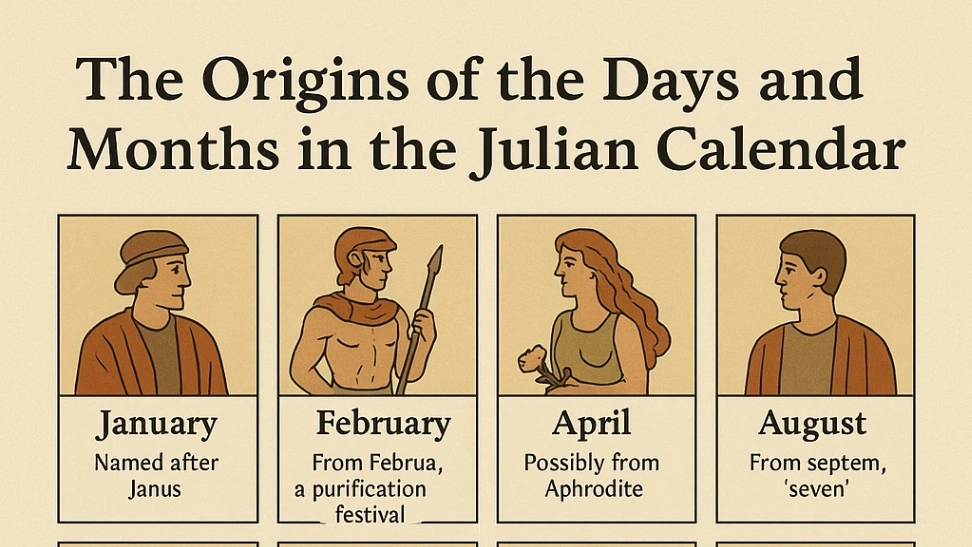The Origins of the Days and Months in the Julian Calendar
The Origins of the Days and Months in the Julian Calendar The Julian calendar, introduced by Julius Caesar in 46 BCE , was a bold reform of the Roman calendar...

TL;DR
The Origins of the Days and Months in the Julian Calendar The Julian calendar, introduced by Julius Caesar in 46 BCE , was a bold reform of the Roman calendar that aligned civil timekeeping with the solar year Many of the names of its months and days have ancient origins — drawn from Roman deities, festivals, and even emperors — and their legacy continues in modern Western languages today DayLa...
Key Takeaways
- 1Many of the names of its months and days have ancient origins — drawn from Roman deities, festivals, and even emperors — and their legacy continues in modern Western languages today
- 2They are a linguistic time capsule, carrying ancient Roman religion, mythology, and astronomy into every modern calendar we still use — from our smartphones to global holidays
- 3🗓️ The Months of the Julian Year January (Ianuarius) – Named after Janus , the two-faced god of beginnings and transitions
The Origins of the Days and Months in the Julian Calendar
The Julian calendar, introduced by Julius Caesar in 46 BCE, was a bold reform of the Roman calendar that aligned civil timekeeping with the solar year. Many of the names of its months and days have ancient origins — drawn from Roman deities, festivals, and even emperors — and their legacy continues in modern Western languages today.
🗓️ The Months of the Julian Year
January (Ianuarius) – Named after Janus, the two-faced god of beginnings and transitions. Janus looks both to the past and the future, symbolizing the doorway to a new year.
February (Februarius) – From Februa, an early Roman purification festival held on February 15. It was a month for cleansing before the start of spring.
March (Martius) – Dedicated to Mars, the god of war. It marked the beginning of the Roman military campaign season and was once the first month of the year.
April (Aprilis) – Possibly derived from aperire, Latin for “to open,” referring to the blossoming of nature. Others link it to Aphrodite, the Greek goddess of love.
May (Maius) – Named after Maia, a fertility goddess associated with growth and abundance.
June (Iunius) – Honors Juno, queen of the gods and protector of marriage and women.
July (Iulius) – Originally called Quintilis (“the fifth month”), it was renamed Julius in honor of Julius Caesar after his death.
August (Augustus) – Formerly Sextilis (“the sixth month”), renamed for Emperor Augustus, who completed many significant victories during this time.
September (September) – From septem, meaning “seven.” It kept its original numerical name even after the calendar shifted to start in January.
October (October) – From octo, meaning “eight.”
November (November) – From novem, meaning “nine.”
December (December) – From decem, meaning “ten.” The last of the original ten months before January and February were added.
🌞 The Days of the Week
The seven-day week was later adopted under the influence of Hellenistic astrology, where each day was governed by one of the seven visible celestial bodies — the Sun, Moon, and five known planets. The names passed through Latin into many European languages.
DayLatin NameDerived FromModern ConnectionSundayDies SolisThe Sun“Sunday” – day of the SunMondayDies LunaeThe Moon“Monday” – day of the MoonTuesdayDies MartisMars“Tuesday” (Tiw’s day in Old English, equivalent of Mars)WednesdayDies MercuriiMercury“Wednesday” (Woden’s day – Norse equivalent of Mercury)ThursdayDies IovisJupiter (Jove)“Thursday” (Thor’s day – Norse Jupiter)FridayDies VenerisVenus“Friday” (Frigg’s day – Norse Venus)SaturdayDies SaturniSaturn“Saturday” – the only one preserving its Latin root directly
🕰️ Legacy and Evolution
The Julian calendar was remarkably accurate for its time, with a year length of 365.25 days, achieved by adding a leap year every four years. However, by the 16th century, small inaccuracies accumulated, prompting the introduction of the Gregorian calendar in 1582 — still in use today.
Yet, the names and cultural meanings of the Julian system endured. They are a linguistic time capsule, carrying ancient Roman religion, mythology, and astronomy into every modern calendar we still use — from our smartphones to global holidays.
Summary:
The Julian calendar didn’t just organize time; it immortalized the gods, emperors, and cosmic order of ancient Rome. Every time we glance at a date — from January 1 to Sunday morning — we are, in a sense, still speaking the language of Julius Caesar’s world.
About the Author
CEO | Futurist | AI Visionary | IT Transformation Leader Owner and CEO of WeRlive LTD, a leading consulting firm specializing in IT project management, CxO-level advisory, and enterprise systems integration. Certified member of the Israel Directory Union (IDU) and an experienced angel investor in emerging technologies. With decades of leadership in IT infrastructure, customer success, and business innovation, I have built a reputation for delivering complex projects with precision, agility, and human-centric excellence. Today, my passion lies at the intersection of technology, artificial intelligence, and future foresight. As a futurist and AI thought leader, I regularly publish strategic articles forecasting the future of AI, the evolution of digital society, and the profound transformations shaping industries and humanity. I help organizations anticipate what's next — by bridging present capabilities with future opportunities. My approach blends deep technical expertise, executive-level strategy, and visionary thinking to empower companies to innovate boldly, navigate change confidently, and build resilience for the decades ahead.
View Profile